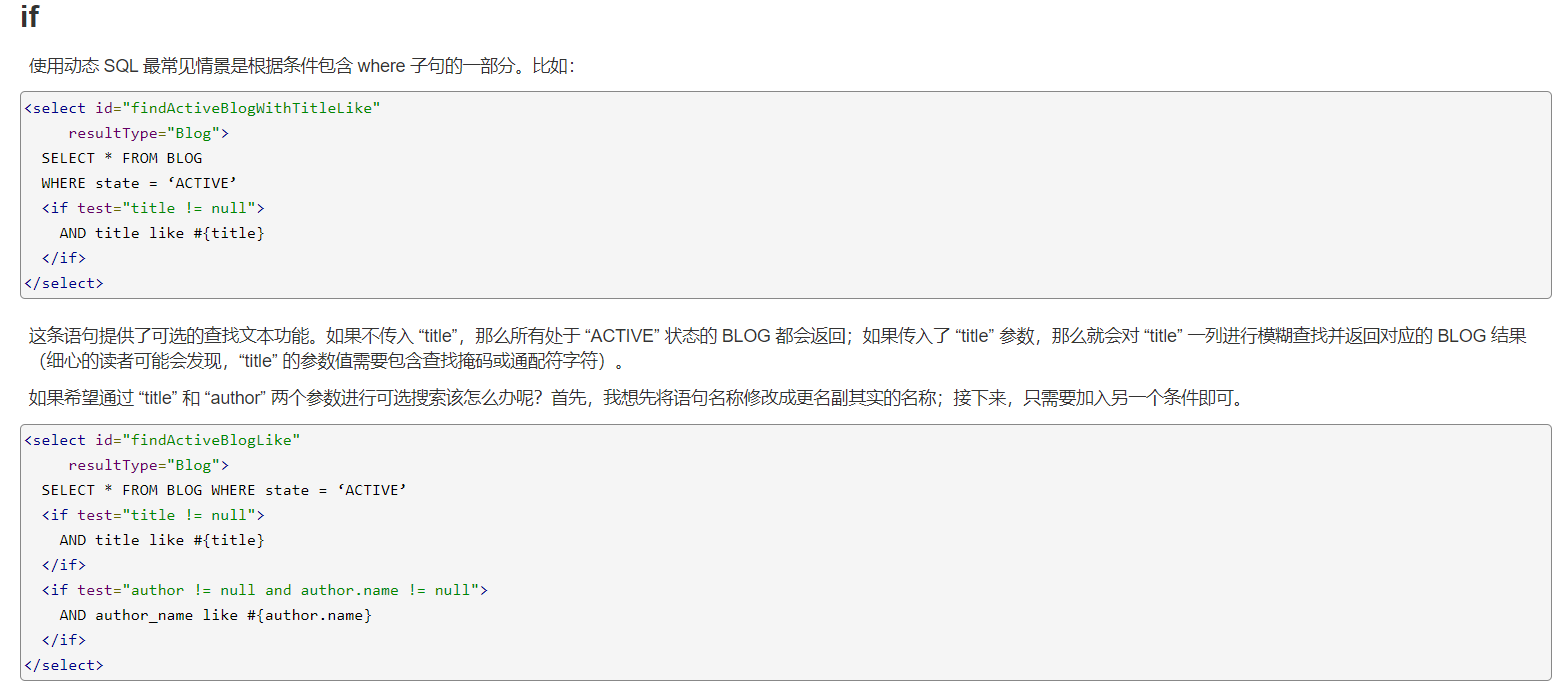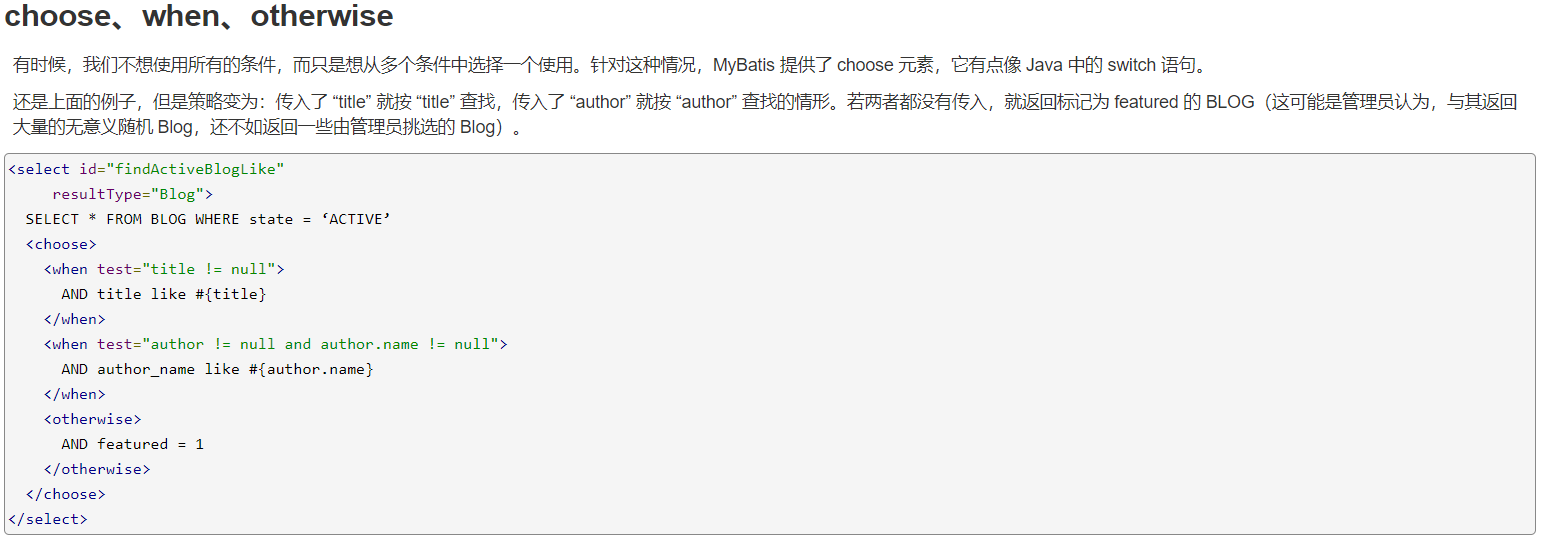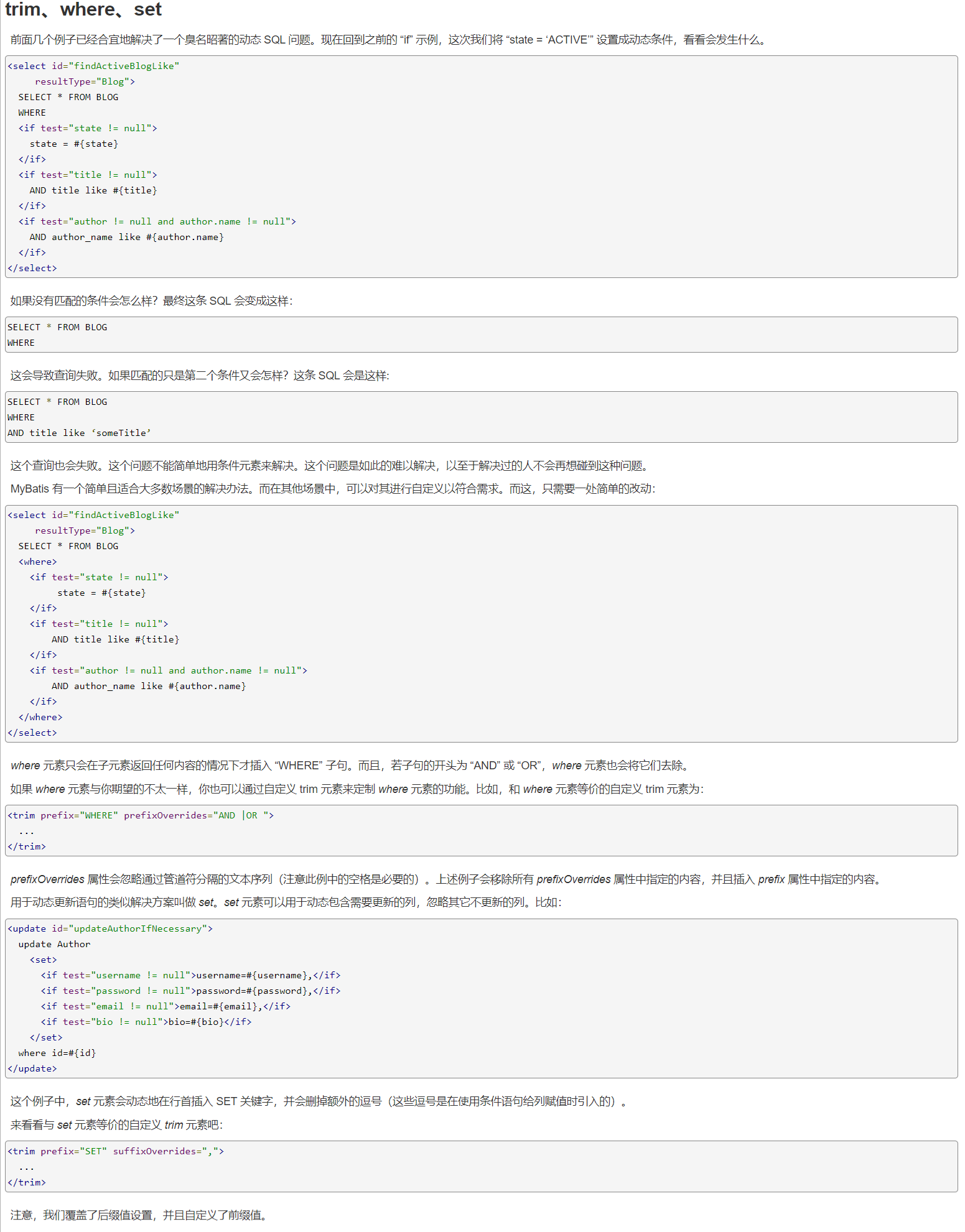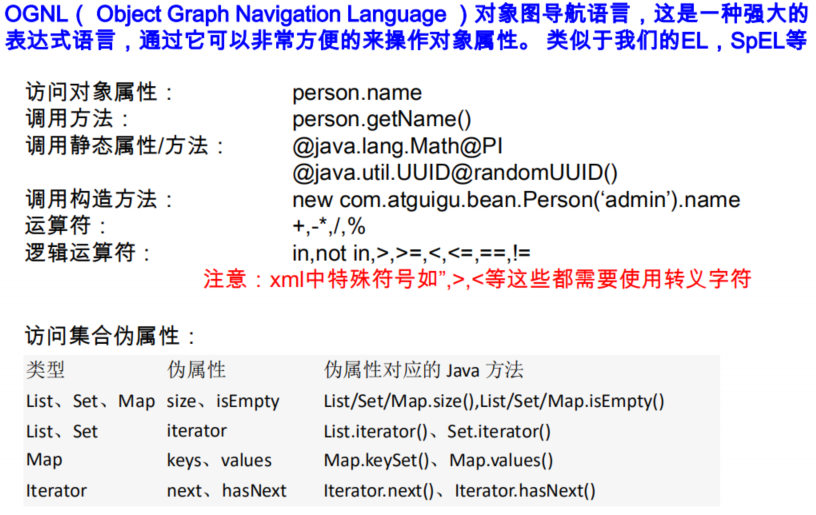04、MyBatis DynamicSQL(Mybatis动态SQL)
1.动态SQL简介
动态 SQL是MyBatis强大特性之一.
动态 SQL 元素和使用 JSTL 或其他类似基于 XML 的文本处理器相似.
MyBatis 采用功能强大的基于 OGNL 的表达式来简化操作.

2.if

1).实现DynamicSQL

public interface EmployeeMapperDynamicSQL {
public List<Employee> getEmpsByCondtionIf(Employee employee);
}
<mapper namespace="com.atguigu.mybatis.dao.EmployeeMapperDynamicSQL">
<!-- 查询员工:携带指定字段查询条件就带上该字段的值 -->
<!-- public List<Employee> getEmpsByCondtionIf(Employee employee) -->
<select id="getEmpsByCondtionIf" resultType="com.atguigu.mybatis.bean.Employee">
select * from tbl_employee
<!-- where:根据条件包含 where 子句 -->
where
<!-- test:判断表达式(OGNL) -->
<!-- OGNL语法参照PPT或者官方文档:http://commons.apache.org/proper/commons-ognl/language-guide.html -->
<!-- 从参数中取值进行判断,如果遇到特殊符号去写转义字符,查W3C HTML ISO-8859-1 参考手册 -->
<if test="id!=null">
id=#{id}
</if>
<!-- <if test="lastName!=null and lastName!="""> -->
<!-- <if test="lastName!=null && lastName!=''"> -->
<if test="lastName!=null && lastName!=""">
and last_name like #{lastName}
</if>
<if test="email!=null and email.trim()!=""">
and email=#{email}
</if>
<!-- ognl会进行字符串与数字的转换判断 "0"==0 -->
<if test="gender==0 or gender==1">
and gender=#{gender}
</if>
</select>
</mapper>
// select * from tbl_employee WHERE id=? and last_name like ? and email=?
// Employee employee = new Employee(3, "%e%","atguigu@atguigu.com", null);
//select * from tbl_employee WHERE id=? and last_name like ?
Employee employee = new Employee(null, "%e%",null, null);
List<Employee> emps = mapper.getEmpsByCondtionIf(employee);
for(Employee emp:emps) {
System.out.println(emp);
}
2.choose
有时候,我们不想使用所有的条件,而只是想从多个条件中选择一个使用.针对这种情况,MyBatis 提供了 choose 元素,它有点像 Java 中的 switch 语句.

public List<Employee> getEmpByConditionChoose(Employee employee);
<mapper namespace="com.atguigu.mybatis.dao.EmployeeMapperDynamicSQL">
<!-- public List<Employee> getEmpByConditionChoose(Employee employee) -->
<select id="getEmpByConditionChoose" resultType="com.atguigu.mybatis.bean.Employee">
select * from tbl_employee
<where>
<!-- 如果带了id就用id查,如果带了lastName就用lastName查;只会进入其中一个 -->
<choose>
<when test="id!=null">
id=#{id}
</when>
<when test="lastName!=null">
last_name like #{lastName}
</when>
<when test="email!=null">
email = #{email}
</when>
<otherwise>
gender = 0
</otherwise>
</choose>
</where>
</select>
</mapper>
//测试choose
Employee employee = new Employee(3, "%e%",null, null);
List<Employee> list = mapper.getEmpByConditionChoose(employee);
for(Employee emp:list) {
System.out.println(emp);
}
3.trim
1).where

public List<Employee> getEmpsByCondtionTrim(Employee employee);
<mapper namespace="com.atguigu.mybatis.dao.EmployeeMapperDynamicSQL">
<!-- public List<Employee> getEmpsByCondtionTrim(Employee employee) -->
<select id="getEmpsByCondtionTrim" resultType="com.atguigu.mybatis.bean.Employee">
select * from tbl_employee
<!-- 后面多出的and或者or where标签不能解决,我们使用trim定制where元素功能 -->
<!-- 自定义字符串的截取规则 -->
<!-- trim:根据条件包含 where 子句 -->
<!-- trim标签体中是整个字符串拼串 后的结果 -->
<!-- 通过自定义 trim 元素来定制 where 元素的功能 -->
<!-- prefix:前缀;prefix给拼串后的整个字符串加一个前缀 如:where <===> <trim prefix="where"> -->
<!-- prefixOverrides:前缀覆盖;去掉整个字符串前面多余的字符 -->
<!-- suffix:后缀;suffix给拼串后的整个字符串加一个后缀 -->
<!-- suffixOverrides:后缀覆盖;去掉整个字符串后面多余的字符 -->
<trim prefix="where" suffixOverrides="and">
<if test="id!=null">
id=#{id} and
</if>
<if test="lastName!=null && lastName!=""">
last_name like #{lastName} and
</if>
<if test="email!=null and email.trim()!=""">
email=#{email} and
</if>
<!-- ognl会进行字符串与数字的转换判断 "0"==0 -->
<if test="gender==0 or gender==1">
gender=#{gender}
</if>
</trim>
</select>
</mapper>
@Test
public void testDynamicSql() throws IOException {
SqlSessionFactory sqlSessionFactory = getSqlSessionFactory();
SqlSession openSession = sqlSessionFactory.openSession();
try {
EmployeeMapperDynamicSQL mapper = openSession.getMapper(EmployeeMapperDynamicSQL.class);
// select * from tbl_employee WHERE id=? and last_name like ? and email=?
// Employee employee = new Employee(3, "%e%","atguigu@atguigu.com", null);
//select * from tbl_employee WHERE id=? and last_name like ?
Employee employee = new Employee(3, "%e%",null, null);
List<Employee> emps = mapper.getEmpsByCondtionIf(employee);
for(Employee emp:emps) {
System.out.println(emp);
} //查询的时候如果某些条件没带可能sql拼装会有问题
//1、给where后面加上1=1,以后的条件都and xxx.
//2、mybatis使用where标签来将所有的查询条件包括在内。
//mybatis就会将where标签中拼装的sql,多出来的and或者or去掉
//where只会去掉第一个多出来的and或者or。 //测试Trim
List<Employee> emps2 = mapper.getEmpsByCondtionTrim(employee);
for(Employee emp:emps2) {
System.out.println(emp);
} } finally {
// : handle finally clause
openSession.close();
}
}
2).set
①.使用set更新
public void updateEmp(Employee employee);
<mapper namespace="com.atguigu.mybatis.dao.EmployeeMapperDynamicSQL">
<update id="updateEmp">
<!-- set:更新拼串 -->
<!-- set标签的使用 -->
update tbl_employee
<set>
<if test="lastName!=null">
last_name=#{lastName},
</if>
<if test="email!=null">
email=#{email},
</if>
<if test="gender!=null">
gender=#{gender}
</if>
</set>
where id=#{id}
</update>
</mapper>
//调试set标签
Employee employee = new Employee(1, "Adminn",null, null);
mapper.updateEmp(employee);
openSession.commit();
②.使用trim拼串更新
public void updateEmp(Employee employee);
<mapper namespace="com.atguigu.mybatis.dao.EmployeeMapperDynamicSQL">
<!-- public void updateEmp(Employee employee) -->
<update id="updateEmp">
<!-- Trim:更新拼串 -->
update tbl_employee
<trim prefix="set" suffixOverrides=",">
<if test="lastName!=null">
last_name=#{lastName},
</if>
<if test="email!=null">
email=#{email},
</if>
<if test="gender!=null">
gender=#{gender}
</if>
</trim>
where id=#{id}
</update>
</mapper>
//调试set标签
Employee employee = new Employee(1, "Adminn",null, null);
mapper.updateEmp(employee);
openSession.commit();
4.foreach

动态 SQL 的另外一个常用的必要操作是需要对一个集合进行遍历,通常是在构建 IN 条件语句的时候.

当迭代列表、集合等可迭代对象或者数组时;index是当前迭代的次数,item的值是本次迭代获取的元素.
当使用字典(或者Map.Entry对象的集合)时,index是键,item是值.
1).MySQL
(1).遍历记录
//查询员工id'在给定集合中的
public List<Employee> getEmpsByConditionForeach(@Param("ids")List<Integer> ids);
<mapper namespace="com.atguigu.mybatis.dao.EmployeeMapperDynamicSQL">
<!-- public List<Employee> getEmpsByConditionForeach(List<Integer> ids) -->
<select id="getEmpsByConditionForeach" resultType="com.atguigu.mybatis.bean.Employee">
<!-- collection:指定要遍历的集合;list类型的参数会特殊处理封装在map中,map的key就是list -->
<!-- item:当前遍历出的元素赋值给指定的变量 -->
<!-- separator:每个元素之间的分隔符 -->
<!-- open:遍历出所有结果拼接一个开始的字符 -->
<!-- close:遍历出所有结果拼接一个结束的字符 -->
<!-- index:索引;遍历list的时候是index就是索引,item就是当前值;遍历map的时候index表示的就是map的key,item就是map的值 -->
<!-- #{变量名}:能取出变量的值也就是当前遍历出的元素 -->
select * from tbl_employee
<foreach collection="ids" item="item_id" separator="," open="where id in(" close=")">
#{item_id}
</foreach>
</select>
</mapper>
//测试foreach
List<Employee> list = mapper.getEmpsByConditionForeach(Arrays.asList(1,2,3,4));
for(Employee emp : list) {
System.out.println(emp);
}
(2).批量保存记录1
public void addEmps(@Param("emps")List<Employee> emps);
<mapper namespace="com.atguigu.mybatis.dao.EmployeeMapperDynamicSQL">
<!-- 批量保存数据 -->
<!-- MySQL下批量保存:可以foreach遍历 mysql支持values(),(),()语法 -->
<!-- public void addEmps(@Param("emps")List<Employee> emps) -->
<!-- insert 方式一 -->
<!-- 推荐使用inert 方式一 -->
<insert id="addEmps">
insert into tbl_employee(last_name,email,gender,d_id)
values
<foreach collection="emps" item="emp" separator=",">
(#{emp.lastName},#{emp.email},#{emp.gender},#{emp.dept.id})
</foreach>
</insert>
</mapper>
List<Employee> emps = new ArrayList<>();
emps.add(new Employee(null, "smith", "smith@atguigu.com", "1",new Department(1)));
emps.add(new Employee(null, "allen", "allen@atguigu.com", "0",new Department(1)));
mapper.addEmps(emps);
openSession.commit();
(3).批量保存记录2
public void addEmps(@Param("emps")List<Employee> emps);
<mapper namespace="com.atguigu.mybatis.dao.EmployeeMapperDynamicSQL">
<!-- insert 方式二 -->
<!-- public void addEmps(@Param("emps")List<Employee> emps) -->
<!-- 这种方式需要数据库连接属性allowMultiQueries=true;
这种分号分隔多个sql可以用于其他的批量操作(删除,修改) -->
<insert id="addEmps">
<foreach collection="emps" item="emp" separator=";">
insert into tbl_employee(last_name,email,gender,d_id)
values(#{emp.lastName},#{emp.email},#{emp.gender},#{emp.dept.id})
</foreach>
</insert>
</mapper>
List<Employee> emps = new ArrayList<>();
emps.add(new Employee(null, "smith", "smith@atguigu.com", "1",new Department(1)));
emps.add(new Employee(null, "allen", "allen@atguigu.com", "0",new Department(1)));
mapper.addEmps(emps);
openSession.commit();
2).Oracle
(1).批量保存1
<mapper namespace="com.atguigu.mybatis.dao.EmployeeMapperDynamicSQL">
<insert id="addEmps" databaseId="oracle">
<!-- oracle第一种批量方式 -->
<!-- <foreach collection="emps" item="emp" open="begin" close="end;">
insert into employees(employee_id,last_name,email)
values(employees_seq.nextval,#{emp.lastName},#{emp.email});
</foreach>
</insert>
</mapper>
(2).批量保存2
<mapper namespace="com.atguigu.mybatis.dao.EmployeeMapperDynamicSQL">
<insert id="addEmps" databaseId="oracle">
<!-- oracle第二种批量方式 -->
insert into employees(
<!-- 引用外部定义的sql -->
<include refid="insertColumn">
<property name="testColomn" value="abc"/>
</include>
)
<foreach collection="emps" item="emp" separator="union"
open="select employees_seq.nextval,lastName,email from("
close=")">
select #{emp.lastName} lastName,#{emp.email} email from dual
</foreach>
</insert>
</mapper>
5.bind
bind 元素可以从 OGNL 表达式中创建一个变量并将其绑定到上下文.

1).bind
若在 mybatis 配置文件中配置了 databaseIdProvider , 则可以使用 “_databaseId”变量,这样就可以根据不同的数据库厂商构建特定的语句.
public List<Employee> getEmpsTestInnerParameter(Employee employee);
<mapper namespace="com.atguigu.mybatis.dao.EmployeeMapperDynamicSQL">
<!-- public List<Employee> getEmpsTestInnerParameter(Employee employee) -->
<!-- mybatis默认还有两个内置参数:_parameter|_databaseId -->
<!-- _parameter:代表整个参数;单个参数:_parameter就是这个参数;多个参数:参数会被封装为一个map,_parameter就是代表这个map -->
<!-- _databaseId:如果配置了databaseIdProvider标签;_databaseId就是代表当前数据库的别名 -->
<select id="getEmpsTestInnerParameter" resultType="com.atguigu.mybatis.bean.Employee">
<!-- bind:可以将OGNL表达式的值绑定到一个变量中,方便后来引用这个变量的值 -->
<if test="_databaseId=='mysql'">
select * from tbl_employee
<if test="_parameter!=null">
where last_name like #{lastName}
</if>
</if>
<if test="_databaseId=='oracle'">
select * from employees
<if test="_parameter!=null">
where last_name like #{_parameter.lastName}
</if>
</if>
</select>
</mapper>
@Test
public void testInnerParam() throws IOException{
SqlSessionFactory sqlSessionFactory = getSqlSessionFactory();
SqlSession openSession = sqlSessionFactory.openSession();
try{
EmployeeMapperDynamicSQL mapper = openSession.getMapper(EmployeeMapperDynamicSQL.class);
Employee employee2 = new Employee();
employee2.setLastName("%e%");
List<Employee> list = mapper.getEmpsTestInnerParameter(employee2);
for (Employee employee : list) {
System.out.println(employee);
}
}finally{
openSession.close();
}
}
2).SQL片段
public void addEmps(@Param("emps")List<Employee> emps);
<mapper namespace="com.atguigu.mybatis.dao.EmployeeMapperDynamicSQL">
<!-- insert 方式三 -->
<insert id="addEmps">
insert into tbl_employee(
<include refid="insertColumn"></include>
)
values
<foreach collection="emps" item="emp" separator=",">
(#{emp.lastName},#{emp.email},#{emp.gender},#{emp.dept.id})
</foreach>
</insert>
<!-- 抽取可重用的sql片段;方便后面引用 -->
<!-- 1、sql抽取:经常将要查询的列名,或者插入用的列名抽取出来方便引用 -->
<!-- 2、include来引用已经抽取的sql -->
<!-- 3、include还可以自定义一些property,sql标签内部就能使用自定义的属性 -->
<!-- include-property:取值的正确方式${prop} #{不能使用这种方式} -->
<sql id="insertColumn">
<if test="_databaseId=='oracle'">
employee_id,last_name,email
</if>
<if test="_databaseId=='mysql'">
last_name,email,gender,d_id
</if>
</sql>
</mapper>
@Test
public void testBatchSave() throws IOException {
SqlSessionFactory sqlSessionFactory = getSqlSessionFactory();
SqlSession openSession = sqlSessionFactory.openSession();
try {
EmployeeMapperDynamicSQL mapper = openSession.getMapper(EmployeeMapperDynamicSQL.class);
List<Employee> emps = new ArrayList<>();
emps.add(new Employee(null, "smith", "smith@atguigu.com", "1",new Department(1)));
emps.add(new Employee(null, "allen", "allen@atguigu.com", "0",new Department(1)));
mapper.addEmps(emps);
openSession.commit();
}finally {
openSession.close();
}
}
6.OGNL

参考文档:http://commons.apache.org/proper/commons-ognl/language-guide.html
https://mybatis.org/mybatis-3/zh/dynamic-sql.html
04、MyBatis DynamicSQL(Mybatis动态SQL)的更多相关文章
- 【mybatis深度历险系列】mybatis中的动态sql
最近一直做项目,博文很长时间没有更新了,今天抽空,学习了一下mybatis,并且总结一下.在前面的博文中,小编主要简单的介绍了mybatis中的输入和输出映射,并且通过demo简单的介绍了输入映射和输 ...
- Mybatis入门之动态sql
Mybatis入门之动态sql 通过mybatis提供的各种标签方法实现动态拼接sql. 1.if.where.sql.include标签(条件.sql片段) <sql id="sel ...
- mybatis 详解------动态SQL
mybatis 详解------动态SQL 目录 1.动态SQL:if 语句 2.动态SQL:if+where 语句 3.动态SQL:if+set 语句 4.动态SQL:choose(when,o ...
- mybatis中的动态SQL
在实际开发中,数据库的查询很难一蹴而就,我们往往要根据各种不同的场景拼接出不同的SQL语句,这无疑是一项复杂的工作,我们在使用mybatis时,mybatis给我们提供了动态SQL,可以让我们根据具体 ...
- Mybatis映射文件动态SQL语句-01
因为在很多业务逻辑复杂的项目中,往往不是简单的sql语句就能查询出来自己想要的数据,所有mybatis引入了动态sql语句, UserMapper.xml <?xml version=" ...
- 6.Mybatis中的动态Sql和Sql片段(Mybatis的一个核心)
动态Sql是Mybatis的核心,就是对我们的sql语句进行灵活的操作,他可以通过表达式,对sql语句进行判断,然后对其进行灵活的拼接和组装.可以简单的说成Mybatis中可以动态去的判断需不需要某些 ...
- MyBatis注解配置动态SQL
MySQL创建表 DROP TABLE IF EXISTS `tb_employee`; CREATE TABLE `tb_employee` ( `id` int(11) NOT NULL AUTO ...
- mybatis框架(5)---动态sql
那么,问题来了: 什么是动态SQL? 动态SQL有什么作用? 传统的使用JDBC的方法,相信大家在组合复杂的的SQL语句的时候,需要去拼接,稍不注意哪怕少了个空格,都会导致错误.Mybatis的动态S ...
- MyBatis进阶使用——动态SQL
MyBatis的强大特性之一就是它的动态SQL.如果你有使用JDBC或者其他类似框架的经验,你一定会体会到根据不同条件拼接SQL语句的痛苦.然而利用动态SQL这一特性可以彻底摆脱这一痛苦 MyBati ...
随机推荐
- centos7安装kafka 转
CentOS7安装和使用kafka 环境准备 安装kafka之前我们需要做一些环境的准备 1.centOS7系统环境 2.jdk环境 3.可用的zookeeper集群服务 安装jdk ...
- go 协程阻塞
func main() { wg.Add(2) go test1() go test2() wg.Wait() } func test1() { defer wg.Done() for i:=0;i& ...
- ImageLoader简介和使用方法
1.功能概要 Android-Universal-Image-Loader是一个开源的UI组件程序,该项目的目的是提供一个可重复使用的仪器为异步图像加载,缓存和显示. (1).使用多线程加载图片(2) ...
- 虚拟机之kali2.0
kali2.0下载地址: 链接: https://pan.baidu.com/s/1CiQJNfvUPFw3aJR103XSbg 提取码: 57wp
- springboot错误统一处理
1,对于404,500这类错误,可以直接新建public/error目录 ,在error目录 中新建404.html, 500.html或5xx.html,springboot会自动跳转到这些静态页面 ...
- day03基本数据类型
运算符补充 今天补充一些简单知识: #!/usr/bin/env python # -*- coding:utf-8 -*- value = "我是中国人" # 判断'中国'是 ...
- Eureka实现注册中心
CAP原则又称CAP定理,指的是在一个分布式系统中,Consistency(一致性). Availability(可用性).Partition tolerance(分区容错性),三者不可得兼.它是分布 ...
- STM32入门系列-存储器与寄存器介绍
介绍两部分内容: 什么是存储器映射 什么是寄存器及寄存器映射 为了让大家对存储器与寄存器有一个更清楚的认识,并且为之后使用 C 语言来访问 STM32 寄存器内容打下基础.等明白了如何使用 C 语言封 ...
- MONGODB03 - 分组计数_分组去重计数(基于 spring-data-mongodb)
前因 项目中有查询MongoDB单表统计相关功能,涉及到MongoDB数据聚合相关操作,其中在多字段分组去重计数相关操作API上资料较少,spring-data-mongodb相关的API介绍也不够直 ...
- mysql处理数据库事务
数据库事务 关注公众号"轻松学编程"了解更多. 1.概念 执行批量操作时,这些操作作为一个整体,要么全部成功,要么全部失败.如银行转账,己方扣钱.对方加钱,这两个操作是一个整体 ...
